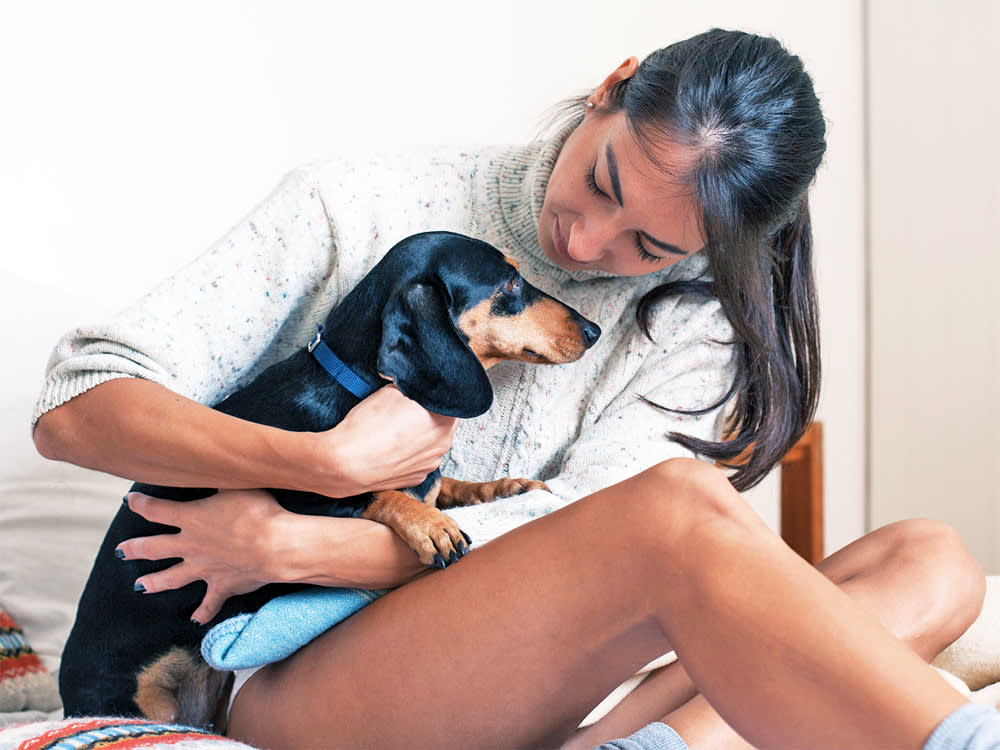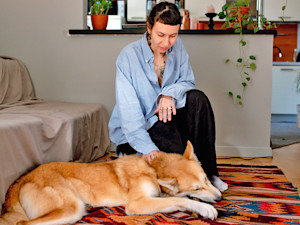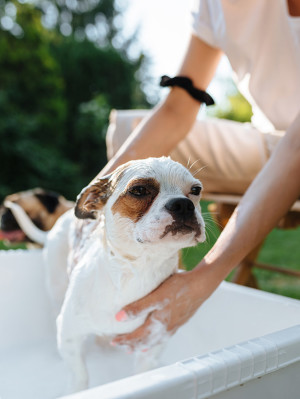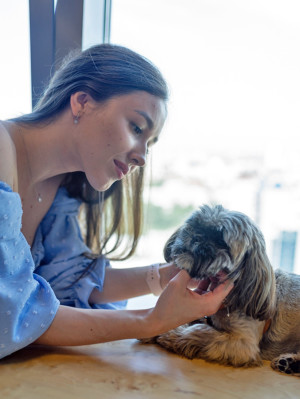How to Identify and Treat Dog Warts
Yes, this is a thing. But don’t worry—here’s how to make them go away.

Share Article
In This Article:
Can Dogs Get Warts? What Are Dog Warts? How to Identify Dog Warts How to Treat Dog Warts How to Prevent the Spread of Dog Warts
If your dog has suddenly sprouted what looks like a mini cauliflower on their lip, don’t freak out. Canine warts are a common sight in younger dogs. And thankfully, they’re usually more annoying than alarming.
Can dogs get warts?
Yes, dogs can get warts — but in most cases, it’s not a major health issue. Sometimes, when I talk to new pet parents about social spaces (like dog parks and daycare), I end up sounding like a Debbie Downer because of all of the potential risks: parvovirus, dog fights, intestinal parasites, respiratory infections, and so on.

Doggie social hour can have risks, but it is also very rewarding and a part of healthy socialization. With that in mind, there is one more thing to add to the list: Those group settings can also spread papilloma warts on dogs.
What are dog warts?
Dog warts, technically called canine viral papillomas, are non-cancerous skin growthsopens in new tab caused by canine papillomavirus. While papilloma warts on dogs sound pretty gross, they typically don’t cause a dog to experience discomfort or illness. They can be a nuisance, though: Depending on their size and location, they can be irritating to dogs and can be a cosmetic issue that bothers some pet parents.
Dogs can get warts on their face, lips, gums, feet, legs, and belly. Oral warts in dogs are more common in puppies and younger dogs, while warts on haired body parts, like the paws and legs, are more common in older, male dogs. A dog might have one single wart or multiple warts in a cluster.
What causes dog warts?
Dog warts are the result of an infection by canine papillomavirus (CPV), which affects the skin and mucosa (think tissue like the gums or inside of the cheek). There are at least seven types of canine papillomavirus, but CPV-1 and CPV-2 are most common. CPV-1 is more likely to cause warts on the face and mouth. CPV-2 is more likely to cause warts on the paws, legs, and belly. About 20 percent of affected dogs are infected with both types at the same time.
Canine papillomavirus is spread through direct contact with infected dogs or via contact with contaminated items such as dog bowls and toys. The virus can live in the environment for several weeks. CPV is most likely to affect dogs with immature or weakened immune systems, so puppies, senior dogs, and dogs on immunosuppressant drugs are most susceptible. But the virus can enter through breaks in any dog’s skin surface. Commonly affected breeds include Pugs, Cocker Spaniels, and Miniature Schnauzers.
When a dog becomes infected with canine papillomavirus, warts don’t pop up right away. The virus has an incubation period of one to two months, after which a dog either:
Has a latent infection, in which the virus lies dormant and does nothing
Has a subclinical infection, in which a dog has no symptoms but may still spread the virus
Has a clinical infection, in which a dog has symptoms (warts) and can spread the virus
How to identify dog warts
Canine viral papillomas tend to start as flat, light-colored lumps, but often progress to fleshy, hairless, cauliflower-like lumps. They can stay flat or become pedunculated (dangly). Sometimes, the warts will be inverted, resembling rounded “cups” with a dark center made up of an accumulation of dead skin cells. Inverted warts can be seen on the paws, limbs, and belly. Dog warts are usually pretty small in size, but can grow to be up to three centimeters in diameter.
Although diagnostic testing is possible, many dog warts are diagnosed using physical examination and history (for example, a young dog who frequents doggy daycare). If there are any concerns about the appearance of the warts, or concerns that they may be due to something else, your vet will collect a sample for cytology or histopathology.
Dog warts can go unnoticed, especially if they are small and do not face much friction. However, mouth warts can become an issue if they become big enough to get in the way of normal eating and drinking. Warts in the mouth can cause noticeable bad breath (halitosis) or bleeding if accidentally bitten. If a wart on a dog’s ear, face, or anywhere else gets scratchedopens in new tab constantly, that could also lead to bleeding and irritation. A wart on a dog’s paw could affect the dog’s gait, making its presence more noticeable.
Where can dogs get warts?
Canine viral papillomas can appear anywhere on the body, but the most common places are the face, ears, paws, and limbs. Common areas for warts to develop include:
Lips
Gums
Beneath the tongue
Muzzle
Legs
Paws
Abdomen
Eyelids
Genital region
How to treat dog warts
Many dog parents fret over how to get rid of dog warts, but if the warts aren’t causing any discomfortopens in new tab, sometimes there’s not much to be done. Treatment options for dog warts include the following.
Watch and wait
In many cases, papilloma warts will go away on their own after a couple of weeks or months. Once a dog’s immune system kicks in to fight the virus, the warts can shrink and go away. If they’re the dangly kind, they can simply fall off. If your dog’s warts aren’t causing any discomfort or irritation, it’s fair to wait and see if they go away on their own. Many vets recommend intervention if the warts don’t resolve after three months. Inverted warts don’t go away without treatment.
Removal
If your dog’s warts are bothersome, become infected, or simply won’t go away, they can be removed. Removal using a scalpel blade (excision), liquid nitrogen (cryosurgery), or laser are common techniques.
Medication
Different medications have been used to treat canine papillomas, including certain antibiotics, antiviral agents, immune modifiers, and retinoids. Depending on the specific drug, medications are given by mouth, via injection, or applied directly to the skin.
Eliminate or reduce immunosuppressants
Sometimes, reducing a dog’s immune-suppressing drugs will allow them to have a better immune response to the virus. This isn’t possible for all dogs who are on these medications long-term, though.
How to prevent the spread of dog warts
Because canine papillomavirus can remain hidden in the environment or in a dog’s body for several weeks, complete avoidance can be difficult to impossible. Socialization is very important for dogs, especially young ones, so the risk of CPV exposure is not a good reason to completely isolate your pup.
I recommend avoiding contact with dogs known to be affected by the virus. If a pup at a dog park or other social space has warts on their face or feet, consider them contagious. Don’t let your dog share any toys, bedding, or water dishes with dogs who have warts.
If your own dog develops warts, keep your dog at home until the warts go away or are removed by your vet.
And one last note: Dog warts are not zoonotic, so they can’t be passed along to humans. If your dog develops warts, you can continue kissing them, if that’s your thing.
Bottom line
Dogs can get warts (non-cancerous skin growths) caused by canine papillomavirus, which is contagious.
Any dog with a wart is likely contagious and should be kept away from other dogs.
Dog warts tend to appear as small, cauliflower-like growths on the mouth, face, feet, or limbs.
Many dog warts will resolve on their own, but sometimes treatment or removal is recommended.
References
Lane, Heather E et al. “Canine oral papillomavirus outbreak at a dog daycare facility.” The Canadian veterinary journal = La revue veterinaire canadienne vol. 58,7 (2017): 747-749. https://pmc.ncbi.nlm.nih.gov/articles/PMC5479657opens in new tab.
Mulherin, Brenda L. “Oral Papillomas in Dogs.” MSD Veterinary Manual, Nov. 2024, www.msdvetmanual.com/digestive-system/diseases-of-the-mouth-in-small-animals/oral-papillomas-in-dogsopens in new tab.
Munday, John S et al. “Papillomaviruses in dogs and cats.” Veterinary journal (London, England: 1997) vol. 225 (2017): 23-31. https://pubmed.ncbi.nlm.nih.gov/28720294opens in new tab.

Dr. Alycia Washington, DVM, MS
Alycia Washington is a small-animal emergency veterinarian with over 10 years of experience based in North Carolina. She works as a relief veterinarianopens in new tab and provides services to numerous emergency and specialty hospitals. She also works as a veterinary writer with a focus on educating pet parents.
Related articles
![Little dog getting showered by his owner in the backyard.]()
How to Treat Dog Skin Diseases at Home
And how you might safely give your pup immediate relief.
Can Dogs Get Pimples? Causes, Symptoms, and Treatments
Time to go to the doggie dermatologist!
Can I Put Coconut Oil on My Dog?
Plus, other alternatives that might be better.
![Ginger dog in high green grass with white flowers.]()
How to Tell If Your Dog Has a Tick
Ticks (literally) suck. Keep an eye out for them on your pup.





